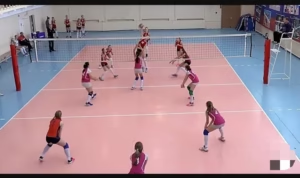Is it a volleyball game or match? Discover the differences between the two terms, “volleyball game” or “volleyball match,” their meanings, and how and when to use each term correctly in professional and casual volleyball with this detailed guide.
When talking about volleyball, you might hear people use the words “volleyball game” and “volleyball match” interchangeably. But are they the same thing? Understanding the difference can help you sound more knowledgeable about the sport, whether you’re a player, coach, or fan.
This article will explain the key volleyball terminology (volleyball game, match, playing fault, point, rally, etc.) in detail, with examples, to enhance your knowledge and enjoyment of the sport.
Volleyball Game or Match

Here, we want to look at what volleyball games and volleyball matches mean. later We will also look at other basic volleyball terms.
What Is a Volleyball Game?
In volleyball, game means set, so volleyball game refers to an individual set played to a predetermined number of points within a match. The objective is to score more points than the opposing team. In volleyball, teams compete to reach a certain number of points (usually 25 in indoor volleyball and 21 in beach volleyball) to win a set (game).
For example, if a team wins a game by scoring 25 points first (with at least a 2-point lead), that does not mean they’ve won the entire competition. Instead, they have won just one part of the full match.
Imagine you’re watching a best-of-five series in indoor volleyball. One team might win the first two games, but the other team can still make a comeback by winning the next three games to take the match.
To win a volleyball game is when a team wins a specific number of points and leads the opposing team by at least two points. Typically, sets are played to 25 points. For example, if a game is played to 25 points and the score is tied at 24-24, play continues until one team leads by 2 points (e.g., 26-24).
Let’s take high school volleyball match between South Lake High School and Mercy High School for example. In the first set, South Lake High School scores 25 points, while Mercy High School scores 23 points. South Lake High School wins the game or set because they reached 25 points and led by at least 2 points.
What Is a Volleyball Match?
A volleyball match consists of multiple games (sets). The team that wins the majority of sets wins the match.
Volleyball Match Formats
Matches are commonly played in two formats:
- Best of three sets or
- Best of five sets.
In a best-of-3 format, the first team to win two sets wins the match. In a best-of-5 format, the first team to win three sets wins the match.
Let’s take college volleyball match between Indiana University and Concordia University as an example. The match is played in a best-of-5 format. Indiana University wins the first two sets, Concordia University wins the third set, and Indiana University wins the fourth set. Indiana University wins the match by winning 3 out of 4 sets.
Volleyball Game vs. Match: Key Differences
| Feature | Volleyball Game | Volleyball Match |
|---|---|---|
| Definition | A single set within a match | A series of games (sets) that determine the winner |
| Points Required | Typically 25 points (21 for beach volleyball) | Best-of-five (indoor) or best-of-three (beach) |
| Purpose | Contributes to the overall match result | Determines the ultimate winner |
| Example | “They won the first game.” | “They won the match 3-2.” |
See Also:
- Beach Volleyball vs Indoor Volleyball: Similarities and Differences
- Volleyball Players Positions and Roles Explained
- Volleyball Tryouts: Evaluation Form & Tips for Selection
- Comprehensive Volleyball Rules for Kids
- Official Volleyball Net Heights for All Levels of Play
- How to be a Good Coach in Volleyball
When to Use ‘Game’ vs. ‘Match’ in Volleyball
It’s common for casual fans to say “game” when they actually mean “match.” However, in professional and competitive volleyball, the correct terminology matters.
- If you’re referring to just one set, say game. Example: “That was a tough game, but we won it 25-23.”
- If you mean the entire event, say match. Example: “We lost the first game but came back to win the match 3-1.”
Common Volleyball Terminology Explained
Besides “game” and “match,” here are other volleyball terms that players and fans should know:
- Set—Another word for “game.”
- Rally—A series of plays leading to a point.
- Serve—The action that starts a rally.
- Spike—A powerful downward hit to score points.
- Block—A defensive move to stop a spike.
- Dig—A low defensive move to prevent the ball from hitting the ground.
How Many Games Are in a Volleyball Match?
The number of games (sets) in a volleyball match depends on the format:
- Indoor volleyball: Best-of-five (up to 5 games)
- Beach volleyball: Best-of-three (up to 3 games)
If a team wins the required number of games early, they don’t need to play the remaining games. For example, if a team wins three straight games in an indoor match, the match ends there.
Do Professionals Say ‘Game’ or ‘Match’?
Professional volleyball players, coaches, and commentators mostly use the word match to refer to the full competition. They use game or set only when discussing individual parts of the match. If you want to sound like a pro, use the correct terms!
Volleyball Scoring System: Game vs. Match
In a volleyball game:
- A team must reach 25 points (indoor) or 21 points (beach) to win.
- There must be a 2-point lead (e.g., 25-23 or 21-19).
In a volleyball match:
- The team must win the majority of games (3 indoors, 2 on the beach) to win the match.
- If teams are tied at 2-2 in an indoor match, a deciding fifth game is played to 15 points.
Other Basic Volleyball Terminology
1. Playing Fault: A fault is a violation of the rules. When a fault occurs, the opposing team is awarded a point.
Types of faults
- Four Hits: A team hits the ball four times before sending it over the net.
- Double Contact: A player contacts the ball twice in succession.
2. Net Violation: when a player touches the net during play.
3. Carry: when a player catches and throws the ball instead of hitting it.
Example: During a high school match at Marshall High School, a player accidentally touches the net while attempting a block. This is a net violation, and the opposing team is awarded a point.
4. Point: A point is awarded to a team at the end of a rally.
5. Scoring Points: Points can be scored in several ways:
- The ball lands on the opponent’s court.
- The opponent hits the ball out-of-bounds.
- The opponent commits a fault.
Example: In a match at Huron High School, the server from New Lenox hits the ball over the net, and it lands on the opponent’s court untouched. New Lenox is awarded a point.
6. Volleyball Rally: rally is the duration of play from the serve until the end of the plays.
7. Volley: volley refers to keeping the ball in play by returning it without committing any faults.
Example: During a match at Hudson High School, a long rally occurs where both teams exchange multiple volleys. Eventually, the ball lands out of bounds on the Hudson High School side, awarding a point to the opposing team.
8. Rally Scoring: In rally scoring, every rally results in a point, regardless of which team served.
Example: In a middle school match at Washington High School, the receiving team wins a rally, resulting in a point for the receiving team. Unlike traditional sideout scoring, rally scoring ensures a point is awarded after every rally.
9. Side Out: When the receiving team wins the rally, it is called a side out. The receiving team then rotates positions and becomes the serving teams.
Example: At a game in South High School, the receiving team successfully returns the serve, and the serving team is unable to return it. This results in a sideout, and the receiving team rotates and prepares to serve.
10. Sideout Scoring: in sideout scoring, a point is only scored by the team that is currently serving. For example, In a traditional match at Central Catholic High School, the serving team wins a rally and scores a point. If the receiving team wins the rally, they gain the serve but do not score a point until they win the rally while serving.
See Also:
- Discover Tijana Bošković Net Worth 2024, Salary, Stats, and Volleyball Highlights
- Discover Melissa Vargas Net Worth 2024, Salary, Stats, and Volleyball Highlights
- Discover Harper Murray Net Worth 2024, Salary, Stats, and Volleyball Highlights
- Discover Leyla Blackwell Net Worth 2024, Bio, Height, Stats, and Volleyball Highlights
- Discover Lexi Rodriguez Net Worth 2024, Salary, Stats, and Volleyball Highlights
Volleyball Coaching Terms
1. Volleyball Coach: is a person responsible for team decisions, such as line-ups, time-outs, and communication with referees.
Example: At Fairfield High School, the volleyball coach decides the starting line-up and calls strategic time-outs to motivate the team.
2. Volleyball Referee: is a person who controls the flow of the match, ensuring rules are followed.
Example: During a match at Mt. Vernon High School, the referee blows the whistle to signal a net violation and awards a point to the opposing team.
3. Overlap: overlap is occurs when players are out of their correct positions during the serve.
Let take for examples, In a game at Ridge Point High School, the referee notices that players are not in their proper positions during the serve, resulting in an overlap fault and a point for the opposing team.
4. Out of alignment: A team is out of alignment if players are not in their correct rotational order at the moment of service contact.
5. Screening: Screening is the illegal placement of players to prevent the opposition from seeing the ball or server.
Example: At a game in Memorial High School, the referee warns a team for screening after players block the opponent’s view of the server.
6. Substitution: when a players allows to enter and leave the game according to specific rules. Example: At Northview High School, the coach substitutes a defensive specialist for a front-row player during a crucial rally.
7. Time-out: A break in action called by a team, usually limited to two per set.
Example: During a tight match at Northridge High School, the coach calls a time-out to discuss strategy and calm the players.
8. Volleyball Hits: A hit, or attack, is when a player jumps and strikes the ball with an overhand swing.
Example: At a match at New Haven High School, a player jumps and delivers a powerful hit that lands on the opponent’s court for a point.
9. Spiker (Hitter): A player who performs the hit or attack.
10. Set: A set is when a player places the ball near the net to assist a spiker.
11. Kill: A successful hit that results in a point. Example: At Shawnee High School, a spiker strike the ball that lands untouched on the opponent’s court, scoring a point.
12. Dig: Dig is a pass on a spiked or hard-hit ball.
13. Bump Pass: A bump pass is done by joining forearms together to pass the ball.
14. Overhead Pass: An overhead pass is taken with the fingers raised overhead.
15. Block: A block is when one or more players jump at the net to prevent the ball from coming over. Example: At a match at Hudson High School, two players execute a double block, stopping the opponent’s spike and winning the point.
FAQs

1. Is volleyball played in sets or games?
Volleyball is played in sets, which are also called games. The terms are interchangeable, but in professional settings, “set” is preferred.
2. Can a volleyball match have only one game?
No, a volleyball match always consists of multiple games. A team must win a majority (e.g., 2 out of 3 or 3 out of 5) to win the match.
3. How many points are needed to win a volleyball game?
- Indoor volleyball: 25 points (15 for the fifth game in a tie-breaker situation)
- Beach volleyball: 21 points (15 in the third game of a deciding match)
4. What happens if both teams have 24 points?
In volleyball, a team must win by at least 2 points. If both teams are tied at 24-24, play continues until one team gains a 2-point lead (e.g., 26-24).
5. Why do some people call a volleyball game a “set”?
In volleyball, “game” and “set” mean the same thing. Some regions and rulebooks prefer “set” to avoid confusion with the word “match.”
Conclusion
Understanding the difference between a volleyball game and a volleyball match helps you follow the sport better and use the right terminology. A game (or set) is just one part of the match, while the match determines the overall winner. Now that you know the difference, you can confidently talk about volleyball like a pro!




